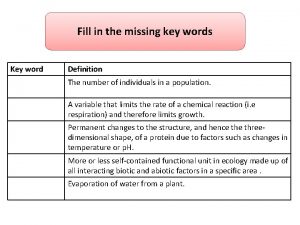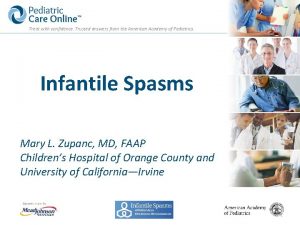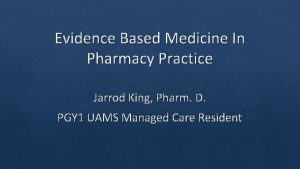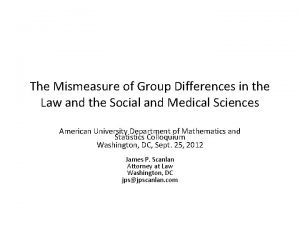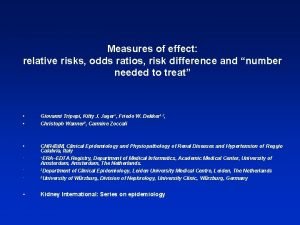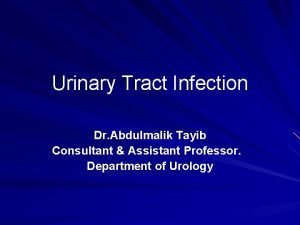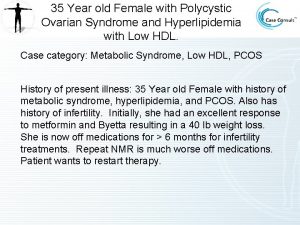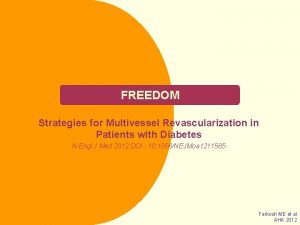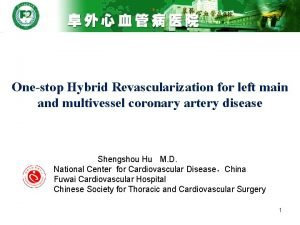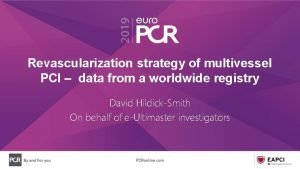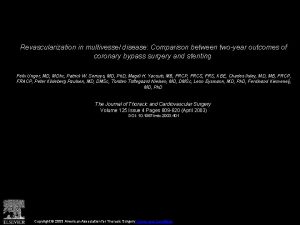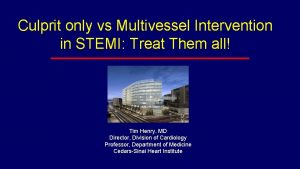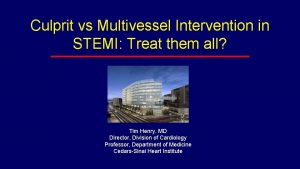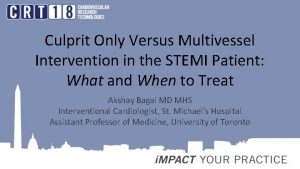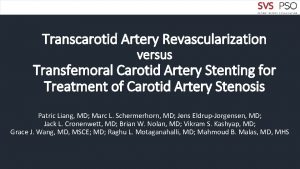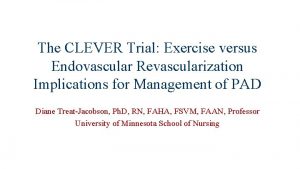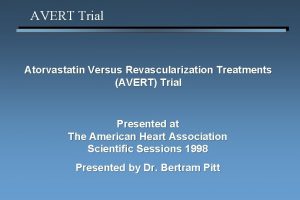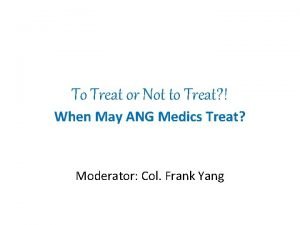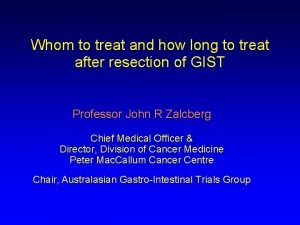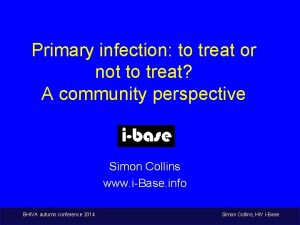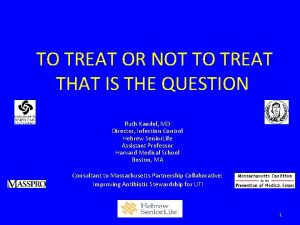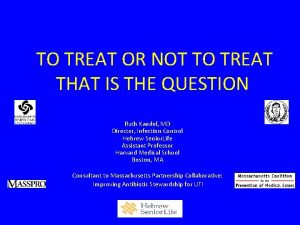Complete Versus CulpritOnly Revascularization Strategies to Treat Multivessel

























- Slides: 25

Complete Versus Culprit-Only Revascularization Strategies to Treat Multivessel Disease After Early PCI for STEMI NEJM, SEP 1 -2019 COMPLETE TRAIL

INTRODUCTION • Primary PCI is the preferred method of reperfusion for patients with STEMI. • Multivessel coronary artery disease with additional angiographically significant lesions. • Routinely revascularize these nonculprit lesions is dilemma.

METHODOLOGY • The COMPLETE trial - multinational, randomized trial. • Patients with STEMI and multivessel coronary disease were randomized to complete revascularization (n = 2, 016) versus culpritonly revascularization (n = 2, 025). • Complete revascularization group- staged PCI during the index hospitalization or after hospital discharge (within 45 days).

• • • Total number of enrollees: 4, 041 Duration of follow-up: 3 years Mean patient age: 62 years Percentage female: 19% Percentage with diabetes: 19%

INCLUSION CRITERIA • Patients with STEMI and multivessel disease – included if they could undergo randomization within 72 hours after successful culprit-lesion PCI.

EXCLUSION CRITERIA • An intention before randomization to revascularize a nonculprit lesion. • A planned surgical revascularization. • Previous coronary-artery bypass grafting surgery.

RANDOMIZATION • Eligible patients - randomly assigned as complete revascularization or culpritlesiononly revascularization according to a computer-generated randomization list with blinding to trial center. • Complete-revascularization group-routine staged PCI. • culprit-lesion-only PCI -guideline-based medical therapy.


OUTCOMES • PRIMARY 1. Cardiovascular death 2. New myocardial infarction. • SECONDARY 1. Death from Cardiovascular causes 2. New myocardial infarction 3. Ischemia-driven revascularization. • SAFETY 1. Major bleeding 2. Contrast-associated acute kidney injury.



CONCLUSION Complete revascularization was associated with a reduction in cardiovascular death or MI. This was accomplished without an significant increase in major bleeding or contrast-induced nephropathy.

• 1) Int J Cardiol. 2017 Feb 1; 228: 844 -852. doi: 10. 1016/j. ijcard. 2016. 11. 186. Epub 2016 Nov 10. • Complete revascularization versus culpritonly revascularization in ST-segment elevation myocardial infarction and multivessel disease patients undergoing primary percutaneous coronary intervention: A meta-analysis and trial sequential analysis.

• Eight RCTs with 2060 patients. • The follow-up was 6 -38 months. • ICR reduced MACE, all-cause death and/or MI, non-fatal MI, and repeat revascularization. • SCR reduced only MACE. • Contrast-induced nephropathy, major hemorrhage, and stroke incidences were not different between CR and COR.

• 2) JACC Cardiovasc Interv. 2017 Feb 27; 10(4): 315 -324. doi: 10. 1016/j. jcin. 2016. 11. 047. • Complete or Culprit-Only Revascularization for Patients With Multivessel Coronary Artery Disease Undergoing Percutaneous Coronary Intervention: A Pairwise and Network Meta. Analysis of Randomized Trials.

• 4 different revascularization strategies - complete revascularization at the index procedure, staged procedure during the hospitalization, staged procedure after discharge or culprit-only revascularization. • RESULT ; -A total - 2, 285 patients. • CR (i. e. , at the index procedure or as a staged procedure) was associated with a lower risk of (MACE). • The risk of all-cause mortality and spontaneous reinfarction was similar.

• 3) Complete Revascularization Versus Culprit Lesion Only in Patients With ST-Segment Elevation Myocardial Infarction and Multivessel Disease( 8, 2019) J Am Coll Cardiol Intv 2019; 12: 721– 30) • A DANAMI-3–PRIMULTI Cardiac Magnetic Resonance Substudy

• Complete FFR-guided revascularization in patients with STEMI and multivessel disease did not affect final infarct size, LV function, or remodeling compared with culprit-only PCI.

THANK YOU

ECG & CASE DISCUSSION • 19 -year-old man presents to an ED with an episode of shortness of breath and syncope. He was mowing his lawn when he began to feel short of breath and light-headed, causing him to go inside where he reportedly "passed out. " • He was unresponsive but did not exhibit any seizure-like activity and he quickly regained consciousness. • He reports having palpitations, described as irregular, forceful beats, and fatigue for the past week, but the rest of his review of systems is grossly normal. • His vitals are: temperature, 96. 7°F (35. 9°C); • pulse rate between 40 and 120 bpm; • respiratory rate, 16 breaths per minute, blood pressure, 102/46 mm Hg; and oxygen saturation of 96% on room air. His physical examination is notable for an irregular tachycardia and multiple, bilateral macular erythematous lesions with central pallor on his thighs.



• The patient is suffering from disseminated Lyme disease. The diagnosis is made based on history, skin lesions, and ECG findings. Approximately 8%-10% of patients with Lyme disease have cardiac involvement. • Presenting symptoms may include lightheadedness, palpitations, or syncope, and are typically caused by a conduction defect ranging from first-degree block to complete atrioventricular dissociation.


• The rhythm strip - an interval of nonconducted Pwaves indicative of complete heart block. • Fortunately, most conduction defects are reversible processes after treatment of the underlying infection. • Other cardiac manifestations of disseminated Lyme disease include myopericarditis, ventricular dysfunction, cardiomegaly, and pericardial effusion with possible tamponade.
 How do we treat the life the life how we treat
How do we treat the life the life how we treat Bacterial growth
Bacterial growth Simple predicate
Simple predicate Invitation to treat
Invitation to treat Why are seedless vascular plants important
Why are seedless vascular plants important How did henry ford spend his money
How did henry ford spend his money Number needed to treat
Number needed to treat The eraser game
The eraser game Treat with confidence
Treat with confidence Which seedless plants have been used to treat bee stings?
Which seedless plants have been used to treat bee stings? Summary of act 2 scene 4 romeo and juliet
Summary of act 2 scene 4 romeo and juliet Who are the mrunas
Who are the mrunas Calculate number needed to harm
Calculate number needed to harm Trick or treat smell my feet give me something good to eat
Trick or treat smell my feet give me something good to eat Equation for number needed to treat
Equation for number needed to treat Mole day treat ideas
Mole day treat ideas Number needed to treat formula
Number needed to treat formula Jay gould childhood
Jay gould childhood Treat the earth well
Treat the earth well How do the nuns identify the wolf-girls?
How do the nuns identify the wolf-girls? Number needed to treat calculation
Number needed to treat calculation Cystitis how to treat
Cystitis how to treat Is byetta used to treat pcos
Is byetta used to treat pcos The persian empire chapter 4 section 3
The persian empire chapter 4 section 3 Nnt formula
Nnt formula Who is mr. kirwin and how does he treat victor?
Who is mr. kirwin and how does he treat victor?

